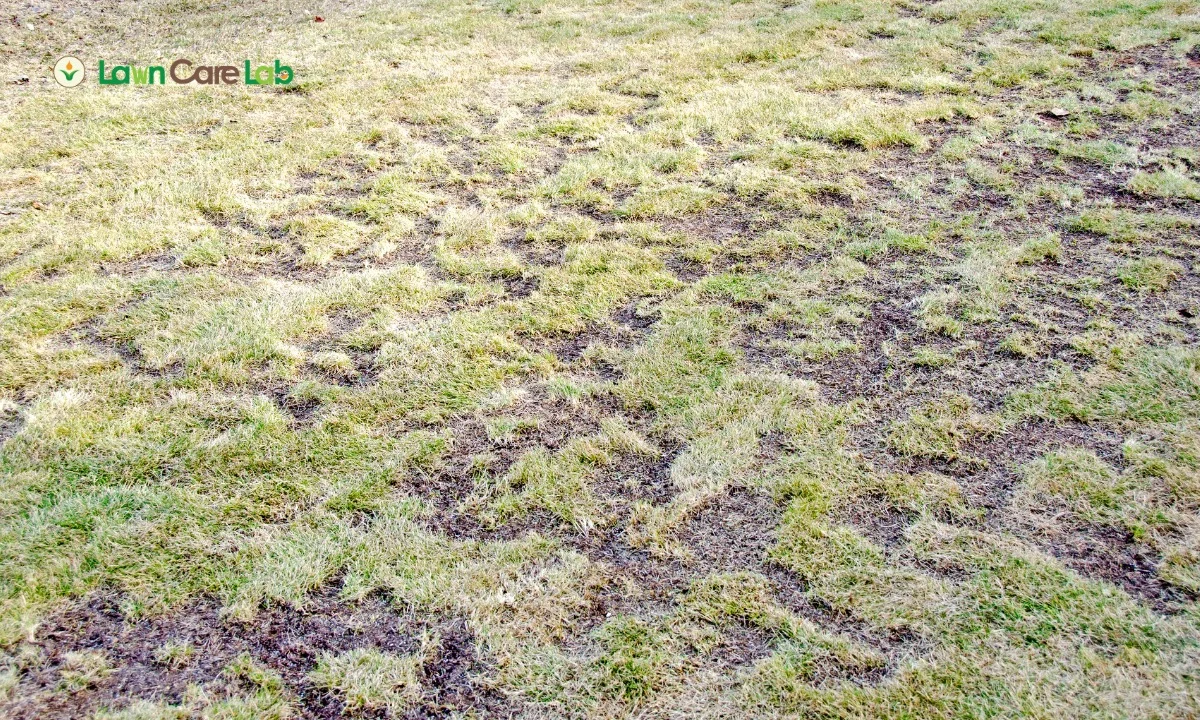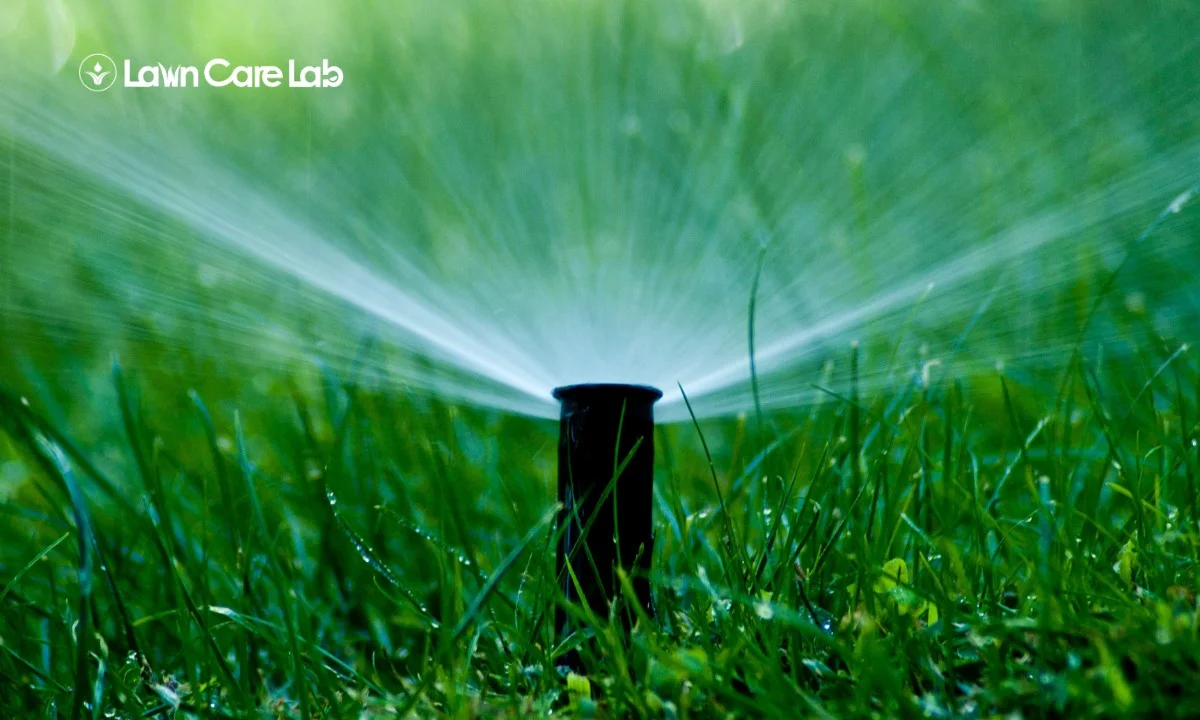Don’t let winter ruin your lawn. Keep up with your fall lawn care routine, adjust watering and mowing height, use winter mulches, and reduce foot traffic.
Let’s ensure your lawn comes out of winter looking as green as ever. It’s not just grass, it’s the green pulse of your home!
So, let’s dive in and see how to Protect Your Lawn From Winter Damage!
Table of Contents
Continue Fall Lawn Care to Boost Winter Hardiness
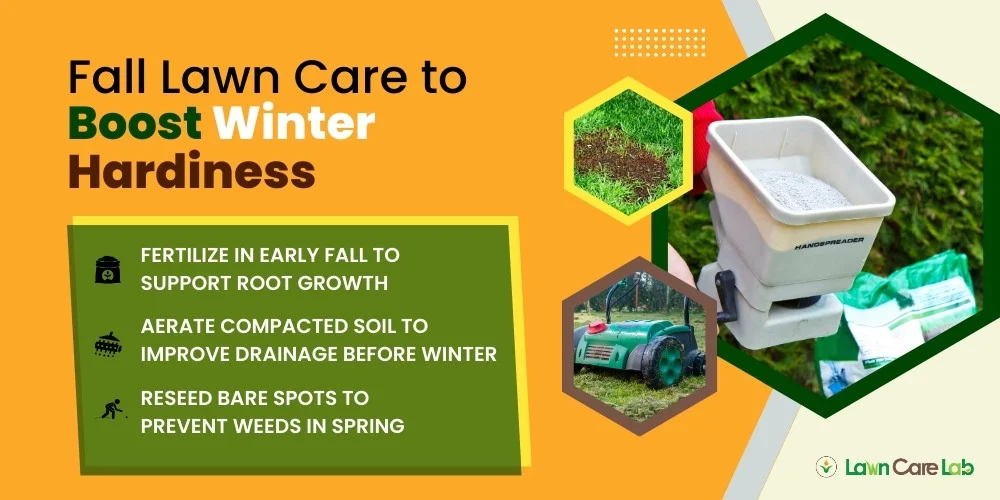
Fall lawn care is important. Fertilize in early fall to strengthen roots for winter.
Aerating your lawn helps to improve drainage by poking small holes in the soil. This allows air and water to flow better and prevents freezing.
Don’t forget to reseed the bald patches on your lawn to prevent weeds from taking over in spring and to promote a lush, green lawn.
Fertilize in Early Fall to Support Root Growth
Fall is the perfect time to give your lawn a little extra care to prepare for winter by supporting the roots.
Here’s how you can do it:
- Feed your lawn: Use slow-release nitrogen-based fertilizer on your lawn to help with cell growth and keep your grass strong.
- Strengthen the roots: Potassium is like the gym for your roots. It helps them bulk up and withstand the cold better.
- Help the roots recover: Phosphorus soothes lawn roots, aiding recovery from summer heat stress.
- Prep for winter: Strong roots are vital for finding moisture in dry winter months.
- Keep the soil moist: This is crucial for your lawn’s energy. Adequate moisture fuels a lush spring.
Aerate Compacted Soil to Improve Drainage Before Winter
Prep your lawn for winter by aerating the soil and feeding it.
Let’s look at it in a simple way:
| What to Do | Why Do It | When to Do It |
|---|---|---|
| Aerate the soil | No more waterlogged soil | Autumn |
| Boost water drainage | Say goodbye to erosion | Before Winter |
| Core aeration | To keep the soil moist | Fall |
| Break up compacted soil | Protects from frostbite | Pre-Winter |
| Winterize your lawn | Keeps your lawn happy during dry winters | Winter |
Reseed Bare Spots to Prevent Weeds in Spring
Don’t skip reseeding bare spots in your fall lawn care routine. It’s like giving your lawn a makeover and helps prevent weeds.
Here are some simple steps to master the art of grass reseeding:
- First, Choose the correct grass seed based on your region – cool-season grasses for the North and warm-season grasses for the South.
- Next, rake the soil lightly to help the seeds sprout.
- Spread the seeds evenly while sowing. A broadcast spreader can save time for big lawns.
Adjust Watering for Cool-Season Grass Dormancy
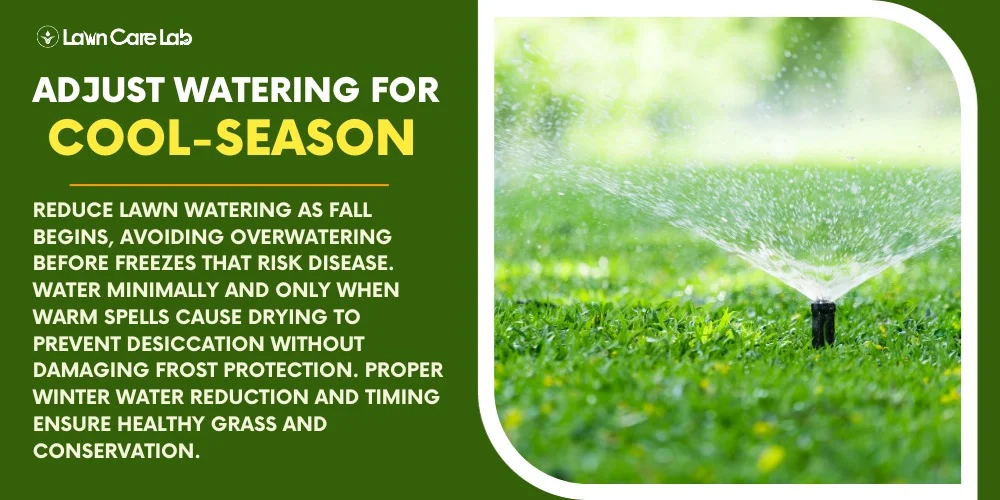
Adjust your watering habits for cool-season grass during winter. Reduce watering schedule as fall begins. Avoid overwatering before freezing temperatures to prevent lawn diseases.
Avoid Overwatering Before Freezes to Prevent Disease
Don’t overwater your lawn before winter. It can cause diseases and pests and interfere with frost protection, leading to winter damage.
| Handy Watering Tips | Disease Dodging | Winter Lawn Love |
|---|---|---|
| Ease up on watering | Dodge overwatering | Keep an eye on frost |
| Cover-up for protection | Dry out before the big freeze | Cover up for protection |
| Keep to a steady schedule | Regular lawn love | Check in often |
Proper watering can keep your lawn lush and healthy during winter.
Water Lightly During Warm Winter Spells to Avoid Desiccation
Watering your lawn with a light sprinkle during warm spells in winter helps prevent drying out. It’s important for lawn health and water conservation.
Here are some simple, clever ideas for looking after your lawn in winter:
- Keep an eye out for signs your lawn is getting dry when the weather’s unusually warm.
- Around mid-day, give your lawn a quick, light watering.
- As soon as the weather cools down, stop watering.
- Regularly check how moist your lawn is.
- Use a tool that measures soil moisture to ensure you’re not giving your lawn too much or too little water.
Now that we’ve covered that, let’s chat about how to keep your lawn at the right height to handle cold weather.
Maintain Proper Mowing Heights for Cold Tolerance
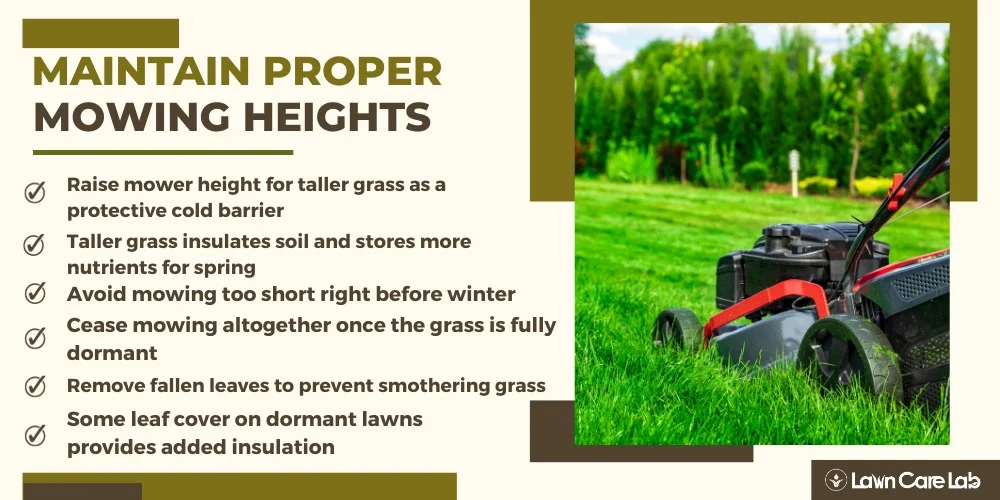
Keep the dead grass leaves on your lawn for warmth, but clear away any debris before it suffocates your grass.
Raise Mower Height for Taller Grass Before Dormancy
Getting Your Lawn Ready for Winter’s Nap
This cool trick acts like a natural blanket for your lawn, and here’s why it works:
- Turning up the mower height- Raise your blade to keep your lawn from drying out.
- Keeping the cold at bay- Taller lawns can act as a cold barrier, protecting your lawn from the chill and ensuring it wakes up green in spring.
- Storing food for spring- Taller grass stores more food for your lawn to use when it wakes up and starts growing again.
- Avoiding the short-cut mistake- Don’t mow your lawn too short before winter. Adjusting how you mow can keep your lawn healthy and lush.
- Staying a bit taller for protection- Keeping your grass taller is crucial for providing extra protection and insulation against any potential damage.
Cease Mowing Once Grass Goes Dormant in Winter
Stop mowing during winter when the grass is dormant. It’s smart lawn care.
Leaving the browning leaves on your lawn during winter is a natural insulator, protecting the soil from freezing and thawing cycles that can cause damage.
Remove Leaf Debris to Avoid Smothering Grass Plants
Fall leaves can harm your lawn by blocking sunlight. Remove them often by raking or blowing them away, especially at the start of the season.
- Pick the right tool that makes leaf cleanup a breeze.
- Clear leaves from your lawn before winter for best results.
Here’s a cool tip: leaving a few leaves on lawns that are already asleep for winter isn’t bad. They can act like a cozy blanket, providing extra insulation and protection during the cold months.
Apply Protective Winter Mulches to Sensitive Areas
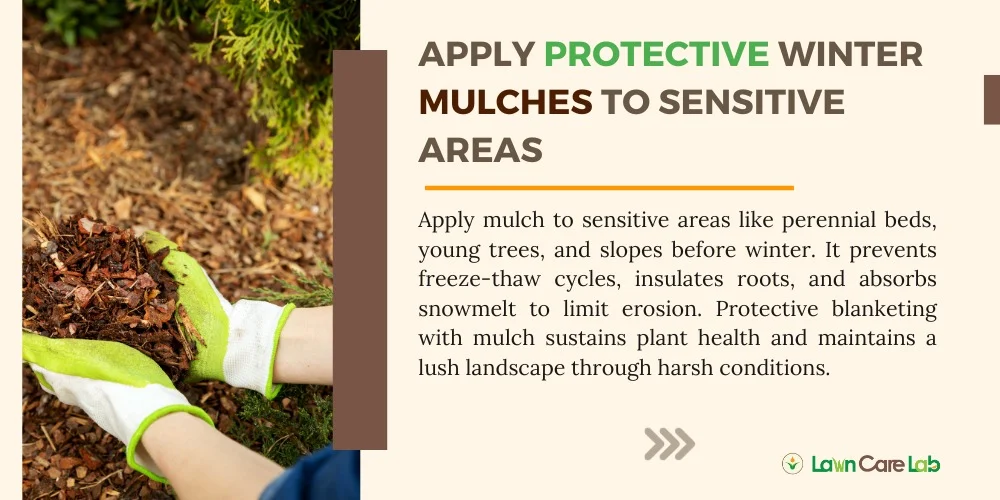
Mulch can help prevent damage from freeze-thaw cycles in perennial beds.
Protect young trees and shrubs with wood chips for optimal growth.
And one more thing – to keep your yard in top shape, especially those exposed slopes, from the onslaught of melting snow, give mulching a shot. It’s a simple yet highly effective solution to prevent soil erosion.
Mulch Prevents Freeze-Thaw Cycles in Perennial Beds
Did you know mulch can protect your plants during winter and prevent them from growing too early?
Let’s dive a little deeper:
- Think of mulch as a cozy blanket: Consistent soil temperature protects your perennial beds from sudden temperature swings.
- Mulch is also your plant’s knight in shining armor: it protects plants from freeze-thaw cycles and frost damage.
- Mulch works like a good manager: Balance and timing prevent premature growth and maintain dormant plants’ hardiness.
Cover Roots of Young Trees/Shrubs with Wood Chips
Protect your saplings during winter by blanketing their roots with wood chips.
Wood chips are like a warm sweater for plant roots, protecting them from harsh winter conditions.
When mulching, avoid piling chips against the trunk to prevent rot. Compost and other mulch also work well.
Choose mulch based on your local climate for the best results.
Mulch Exposed Slopes to Limit Erosion from Snowmelt
Mulch can help prevent soil erosion during snowmelt in sloped gardens. Let’s discuss some interesting topics.
Sloped lawns are prone to erosion from melting snow in spring. Applying a 2-3 inch layer of shredded bark or compost mulch before winter prevents soil loss and plant damage.
Mulch also absorbs meltwater, preventing surface runoff and ensuring stability after snow melts.
Minimize Traffic and Activities on Dormant Winter Lawns
To maintain a healthy lawn, avoid walking on it too much, especially in snowy weather.
Also, designate a specific area for your pets to do their business to prevent damage.
Don’t use deicing salts on the lawn, as they can harm the grass when it grows in spring.
Avoid Compacting Snow with Excess Foot Traffic
To make sure you’re stopping the snow from getting compacted and keeping your grass safe, think about these easy-to-do steps:
- Stick to the path: Try only walking on your main routes when moving around your yard.
- Set up a play spot: If you’ve got kids or pets, give them a particular area to have fun.
- Keep the snow soft and light: Try not to stomp it down. Less footprints in the snow keeps it fluffy, which is better for when it melts.
Keep these steps in mind for a healthy lawn in the spring.
Prevent Pet Urine Damage with Designated Relief Areas
Create a specific area for your pet to relieve themselves to avoid salt damage to your lawn in winter.
Provide a bathroom for your furry friend with urine-resistant materials like wood chips or gravel to prevent damage to your lawn.
Directing your pets to these spots can help save your lawn from damage and keep your yard looking great.
More threats to your lawn in winter – like salt on snow-covered grass. More on that later.
Maintain a healthy, vibrant yard with innovation and forward-thinking even in chilly months.
Prohibit Salt Use on Snow-Covered Grass to Prevent Burn
Salt and other de-icing chemicals can damage dormant grass, causing brown patches that persist even after the snow melts.
It’s best to avoid using it and try other winter lawn care tricks.
To prevent winter salt damage:
- Clearly mark snow-covered lawn areas to prohibit salt application by those providing winter maintenance.
- Opt for non-salt calcium magnesium acetate (CMA) deicers labeled as lawn-safe.
- Manually sweep excess salt residue off grass areas to limit contact time.
- Water lightly after salt exposure to dilute salinity if not frozen.
- Evaluate and treat any chemical burn areas in early spring to restore grass.
Prevent winter kill damage by avoiding salt on dormant lawns.
Conclusion
Winter lawn care is easy – prepare it and tend to it regularly. Give your lawn the attention it deserves this winter!
Take care of your lawn in the fall, change up your watering, mow regularly, and show extra love to delicate spots. Your lawn’s health is in your hands.
Frequently Asked Questions
How Does the Type of Grass Affect Its Winter Hardiness?
Grass types handle winter differently. Bermuda needs extra care to survive, while fescue tolerates the cold well. Knowing this helps maintain a green lawn year-round.
Are There Any Specific Lawn Fertilizers That Work Best in Winter?
Use winter fertilizers rich in potassium to help your lawn withstand the cold. Organic options are available, too. Apply before the frost sets in, choose a fertilizer that suits your lawn, and ensure proper storage.
How Does Snowfall Impact the Health of My Lawn During Winter?
Snowfall can harm your lawn’s health during winter by causing snow mold. To keep your lawn healthy, water it during winter, prevent ice damage, and mitigate salt damage.
How Can I Protect My Lawn From Diseases and Pests During Winter Months?
Winter mulching, disease preventatives, and pest repellants can protect your lawn during winter. Frost protection and planting cold-resistant grasses can also help.
Can I Use a Lawn Aerator During Winter, and How Does It Help Protect My Lawn?
Absolutely! A lawn aerator can be your winter buddy, allowing air, water, and nutrients to seep in easily. This simple act can protect your lawn from harsh winter elements.
- How Green Spaces Influence Community Interactions - July 8, 2024
- Lawn Fungal Diseases: Identification and Treatment - July 3, 2024
- Lawn Care for All Seasons: A Year-Round Guide for Extreme Climates - June 24, 2024

